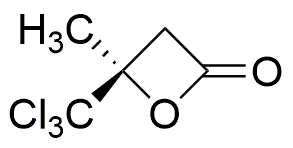(R)-(+)-4-Methyl-4-(trichloromethyl)-2-oxetanone is widely utilized in research focused on
- Synthesis of Pharmaceuticals: This compound serves as a key intermediate in the synthesis of various pharmaceutical agents, particularly in the development of anti-inflammatory and analgesic drugs.
- Agrochemical Development: It is employed in the formulation of agrochemicals, helping to enhance the efficacy of pesticides and herbicides, thereby improving crop yields.
- Polymer Chemistry: The compound is used in the production of specialty polymers, which are essential in creating materials with specific properties for various industrial applications.
- Research in Organic Chemistry: It acts as a valuable reagent in organic synthesis, facilitating the study of reaction mechanisms and the development of new synthetic methodologies.
- Environmental Applications: This chemical is explored for its potential in environmental remediation processes, particularly in breaking down harmful pollutants in soil and water.
General Information
Properties
Safety and Regulations
Applications
(R)-(+)-4-Methyl-4-(trichloromethyl)-2-oxetanone is widely utilized in research focused on
- Synthesis of Pharmaceuticals: This compound serves as a key intermediate in the synthesis of various pharmaceutical agents, particularly in the development of anti-inflammatory and analgesic drugs.
- Agrochemical Development: It is employed in the formulation of agrochemicals, helping to enhance the efficacy of pesticides and herbicides, thereby improving crop yields.
- Polymer Chemistry: The compound is used in the production of specialty polymers, which are essential in creating materials with specific properties for various industrial applications.
- Research in Organic Chemistry: It acts as a valuable reagent in organic synthesis, facilitating the study of reaction mechanisms and the development of new synthetic methodologies.
- Environmental Applications: This chemical is explored for its potential in environmental remediation processes, particularly in breaking down harmful pollutants in soil and water.
Documents
Safety Data Sheets (SDS)
The SDS provides comprehensive safety information on handling, storage, and disposal of the product.
Product Specification (PS)
The PS provides a comprehensive breakdown of the product’s properties, including chemical composition, physical state, purity, and storage requirements. It also details acceptable quality ranges and the product's intended applications.
Certificates of Analysis (COA)
Search for Certificates of Analysis (COA) by entering the products Lot Number. Lot and Batch Numbers can be found on a product’s label following the words ‘Lot’ or ‘Batch’.
*Catalog Number
*Lot Number
Certificates Of Origin (COO)
This COO confirms the country where the product was manufactured, and also details the materials and components used in it and whether it is derived from natural, synthetic, or other specific sources. This certificate may be required for customs, trade, and regulatory compliance.
*Catalog Number
*Lot Number
Safety Data Sheets (SDS)
The SDS provides comprehensive safety information on handling, storage, and disposal of the product.
DownloadProduct Specification (PS)
The PS provides a comprehensive breakdown of the product’s properties, including chemical composition, physical state, purity, and storage requirements. It also details acceptable quality ranges and the product's intended applications.
DownloadCertificates of Analysis (COA)
Search for Certificates of Analysis (COA) by entering the products Lot Number. Lot and Batch Numbers can be found on a product’s label following the words ‘Lot’ or ‘Batch’.
*Catalog Number
*Lot Number
Certificates Of Origin (COO)
This COO confirms the country where the product was manufactured, and also details the materials and components used in it and whether it is derived from natural, synthetic, or other specific sources. This certificate may be required for customs, trade, and regulatory compliance.


